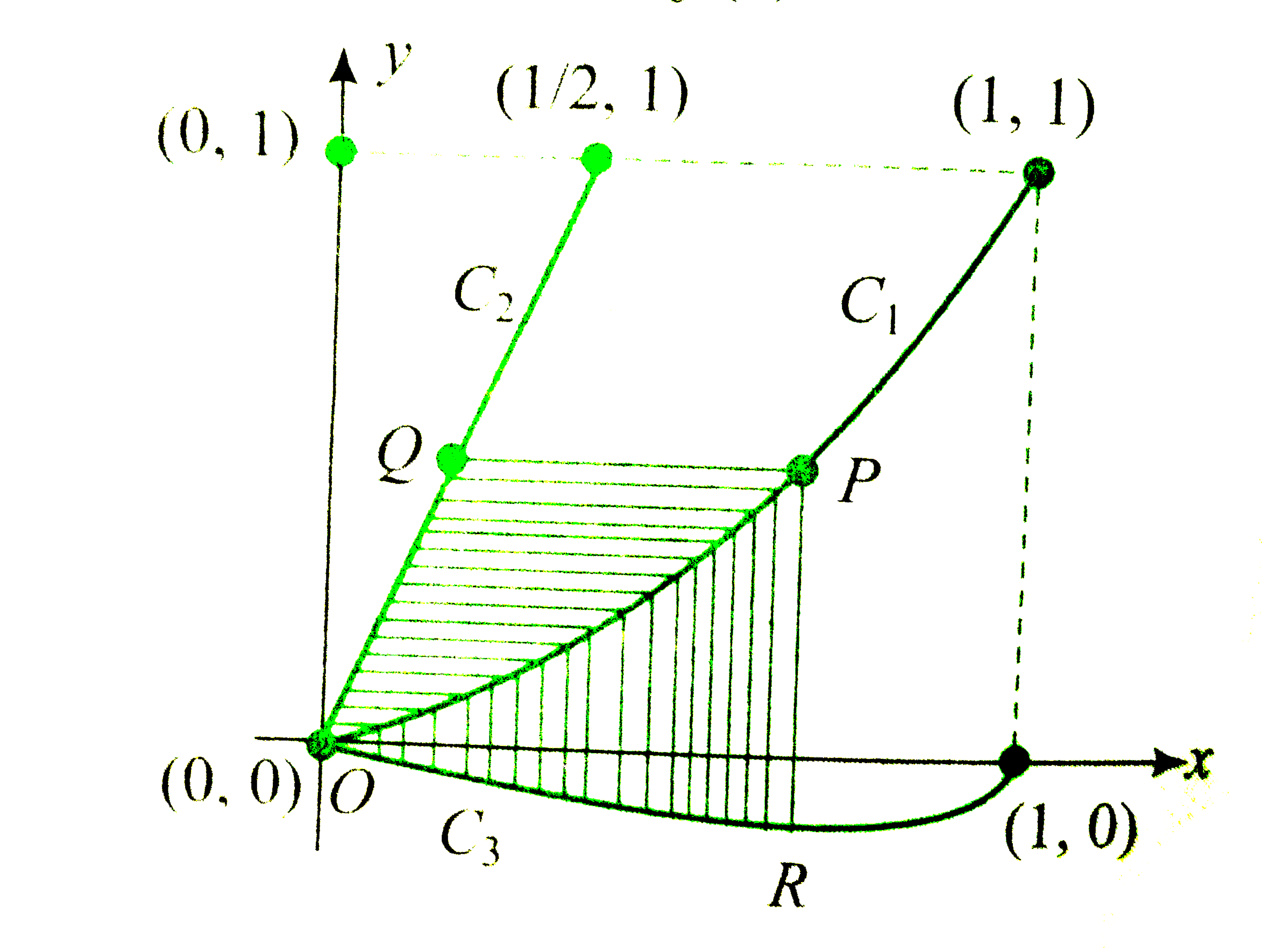Let be the graphs of the functions and respectively, where Let be the graph of a function where For a point on let the lines through parallel to the axis, meet and at and respectively (see Figure). If for every position of the areas of the shaded regions and are equal, determine the function
To solve the problem, we need to determine the function f(x) such that the areas of the regions OPQ and ORP are equal for any point P on the curve C1 defined by y=x2.
1. Identify the curves:
- The curves are given as:
- C1:y=x2
- C2:y=2x
- C3:y=f(x)
- The domain for x is 0<x<1.
2. Find the coordinates of points P, Q, and R:
- Let P be a point on C1 at (x,x2).
- The line through P parallel to the y-axis meets C2 at point Q and C3 at point R.
- The coordinates of Q are (x,2x) and the coordinates of R are (x,f(x)).
3. Calculate the areas of regions OPQ and ORP:
- The area of triangle OPQ can be calculated as:
AreaOPQ=12×base×height=12×x×(2x−x2)=12x(2x−x2)=12(2x2−x3)
- The area of triangle ORP is:
AreaORP=12×base×height=12×x×(f(x)−x2)=12x(f(x)−x2)
4. Set the areas equal:
- Since the areas are equal, we have:
12(2x2−x3)=12x(f(x)−x2)
- Simplifying this gives:
2x2−x3=x(f(x)−x2)
- Dividing both sides by x (for x≠0):
2x−x2=f(x)−x2
- Rearranging gives:
f(x)=2x
5. Final expression for f(x):
- Thus, we find that:
f(x)=2x
Conclusion:
The function f(x) that satisfies the condition of equal areas for the regions OPQ and ORP is:
f(x)=2x
- The curves are given as:
- C1:y=x2
- C2:y=2x
- C3:y=f(x)
- The domain for x is 0<x<1.
- Let P be a point on C1 at (x,x2).
- The line through P parallel to the y-axis meets C2 at point Q and C3 at point R.
- The coordinates of Q are (x,2x) and the coordinates of R are (x,f(x)).
- The area of triangle OPQ can be calculated as:
AreaOPQ=12×base×height=12×x×(2x−x2)=12x(2x−x2)=12(2x2−x3)
- The area of triangle ORP is:
AreaORP=12×base×height=12×x×(f(x)−x2)=12x(f(x)−x2)
- Since the areas are equal, we have:
12(2x2−x3)=12x(f(x)−x2)
- Simplifying this gives:
2x2−x3=x(f(x)−x2)
- Dividing both sides by x (for x≠0):
2x−x2=f(x)−x2
- Rearranging gives:
f(x)=2x
- Thus, we find that:
f(x)=2x
The function f(x) that satisfies the condition of equal areas for the regions OPQ and ORP is:
f(x)=2x
Topper's Solved these Questions
Similar Questions
Let C1andC2 be the graphs of the functions y=x2andy=2x, respectively, where 0≤x≤1. Let C3 be the graph of a function y=f(x), where 0≤x≤1,f(0)=0. For a point P on C1, let the lines through P, parallel to the axes, meet C2andC3 at Q and R, respectively (see figure). If for every position of P(onC1), the areas of the shaded regions OPQ and ORP are equal, determine the function f(x).

View SolutionExamine the continuity of the function f(x)={3x−2, x≤0x+1, x>0 at x=0 . Also sketch the graph of this function.
View SolutionMake a rough sketch of the graph of the function y=4−x2, 0≤x≤2 and determine the area enclosed by the curve, the x-axis and the lines x=0 and x=2.
View SolutionDraw the graph of the function
f(x)=⎧⎪⎨⎪⎩1 if x>00 if x=0-1 if x<0,x∈R
View SolutionExamine the continuity of the function f(x)=3x−2,x≤0, f(x)=x+1,x>0 at x=0 Also sketch the graph of this function.
View SolutionLet f:[0,1]→[0,1] be a continuous function. Then prove that f(x)=x for at least one 0≤x≤1.
View SolutionDiscuss the applicability of Rolles theorem on the function f(x)={x2+1, when 0≤x≤13−x, when 1<x≤2
View SolutionDiscuss the applicability of Rolles theorem on the function f(x)={x2+1if 0≤x≤13−xif1<x≤2
View SolutionLet f(x)=asinx+c, where a and c are real numbers and a>0. Then f(x)<0,∀x∈R if
View SolutionIn the hexaploid wheat, the haploid (n) and basic (x) numbers of chromosomes are
View Solution
